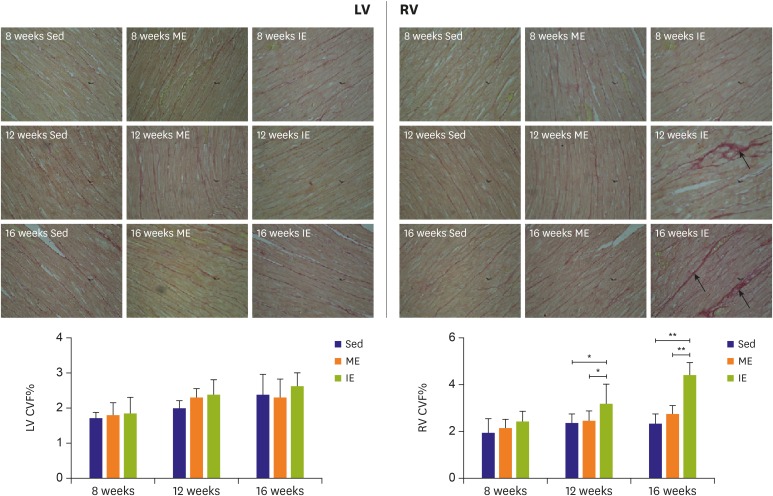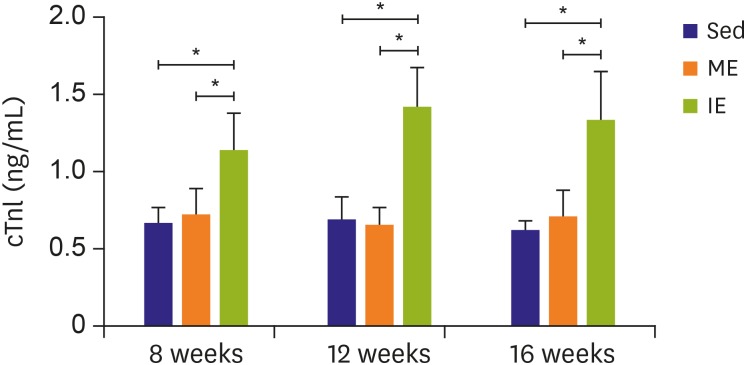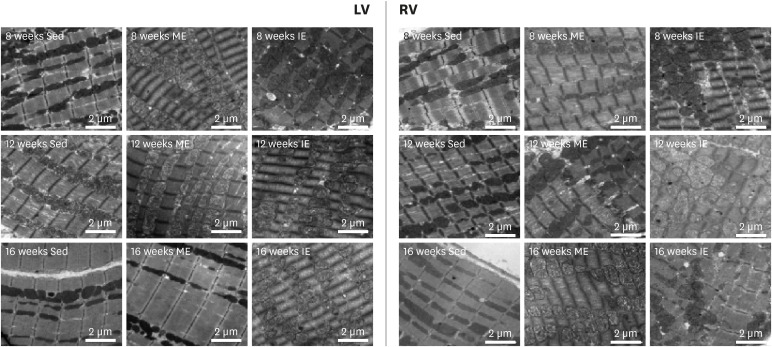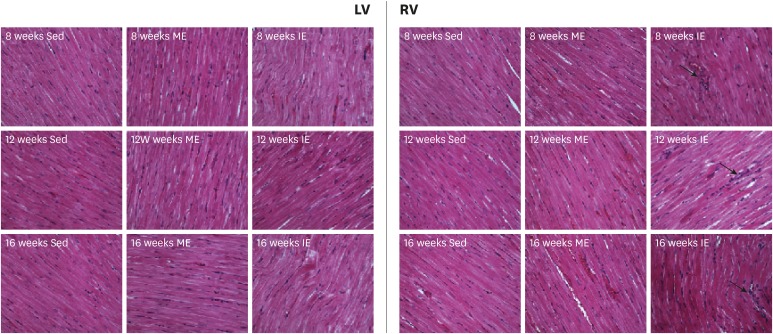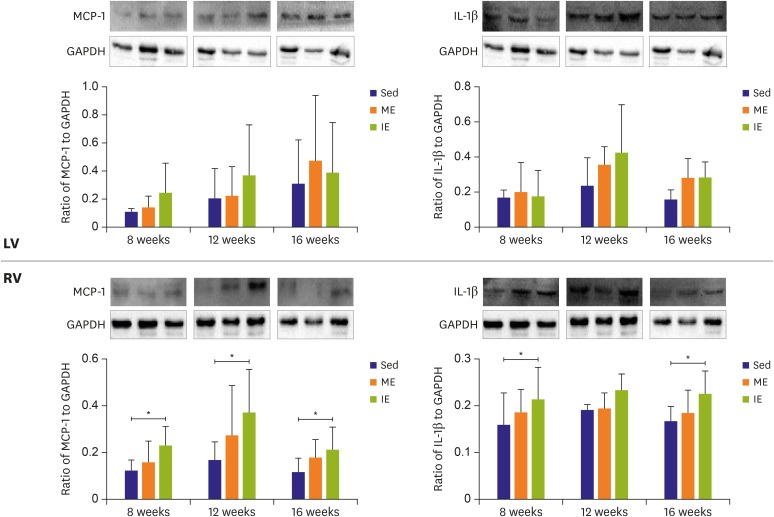Korean Circ J.
2018 Nov;48(11):1014-1024. 10.4070/kcj.2018.0084.
Exercise induced Right Ventricular Fibrosis is Associated with Myocardial Damage and Inflammation
- Affiliations
-
- 1School of Kinesiology, Shanghai University of Sport, Shanghai, China. raoz17@ecu.edu
- 2Sport Health and Rehabilitation Center, China Institute of Sport Science, Beijing, China.
- 3Department of Kinesiology, East Carolina University, Greenville, NC, USA.
- 4Hunan University of Technology, Zhuzhou, China.
- KMID: 2422550
- DOI: http://doi.org/10.4070/kcj.2018.0084
Abstract
- BACKGROUND AND OBJECTIVES
Intense exercise (IE) induced myocardial fibrosis (MF) showed contradictory findings in human studies, making the relationship between IE and the development of MF unclear. This study aims to demonstrate exercise induced MF is associated with cardiac damage, and inflammation is essential to the development of exercise induced MF.
METHODS
Sprague-Dawley rats were submitted to daily 60-minutes treadmill exercise sessions at vigorous or moderate intensity, with 8-, 12-, and 16-week durations; time-matched sedentary rats served as controls. Enzyme-linked immunosorbent assay (ELISA) was used to measure serum cardiac troponin I (cTnI) concentration. After completion of the exercise protocol rats were euthanized. Biventricular morphology, ultrastructure, and collagen deposition were then examined. Protein expression of interleukin (IL)-1β and monocyte chemotactic protein (MCP)-1 was evaluated in both ventricles.
RESULTS
After IE, right but not left ventricle (LV) MF occurred. Serum cTnI levels increased and right ventricular damage was observed at the ultrastructure level in rats that were subjected to long-term IE. Leukocyte infiltration into the right ventricle (RV) rather than LV was observed after long-term IE. Long-term IE also increased protein expression of pro-inflammation factors including IL-1β and MCP-1 in the RV.
CONCLUSIONS
Right ventricular damage induced by long-term IE is pathological and the following inflammatory response is essential to the development of exercise induced MF.
Keyword
MeSH Terms
Figure
Cited by 2 articles
-
Prolonged Intensive Exercise: When the Right Ventricle Goes Wrong
Yoonjee Park, Eung Ju Kim
Korean Circ J. 2018;48(11):1025-1027. doi: 10.4070/kcj.2018.0218.Sex Differences in Cardiac Remodeling in Athletes: Men on the Left, Women on the Right?
Chi Young Shim
Korean Circ J. 2021;51(5):439-440. doi: 10.4070/kcj.2021.0021.
Reference
-
1. Benito B, Gay-Jordi G, Serrano-Mollar A, et al. Cardiac arrhythmogenic remodeling in a rat model of long-term intensive exercise training. Circulation. 2011; 123:13–22. PMID: 21173356.2. Gay-Jordi G, Guash E, Benito B, et al. Losartan prevents heart fibrosis induced by long-term intensive exercise in an animal model. PLoS One. 2013; 8:e55427. PMID: 23383330.3. Wilson M, O’Hanlon R, Prasad S, et al. Diverse patterns of myocardial fibrosis in lifelong, veteran endurance athletes. J Appl Physiol. 1985; 2011:1622–1626.4. Schnell F, Claessen G, La Gerche A, et al. Subepicardial delayed gadolinium enhancement in asymptomatic athletes: let sleeping dogs lie? Br J Sports Med. 2016; 50:111–117. PMID: 26224114.5. McDiarmid AK, Swoboda PP, Erhayiem B, et al. Athletic cardiac adaptation in males is a consequence of elevated myocyte Mass. Circ Cardiovasc Imaging. 2016; 9:e003579. PMID: 27033835.6. Sanchis-Gomar F, López-Ramón M, Alis R, et al. No evidence of adverse cardiac remodeling in former elite endurance athletes. Int J Cardiol. 2016; 222:171–177. PMID: 27494731.7. van de Schoor FR, Aengevaeren VL, Hopman MT, et al. Myocardial Fibrosis in Athletes. Mayo Clin Proc. 2016; 91:1617–1631. PMID: 27720455.8. Prabhu SD, Frangogiannis NG. The biological basis for cardiac repair after myocardial infarction: from inflammation to fibrosis. Circ Res. 2016; 119:91–112. PMID: 27340270.9. Eijsvogels TM, Hoogerwerf MD, Oudegeest-Sander MH, Hopman MT, Thijssen DH. The impact of exercise intensity on cardiac troponin I release. Int J Cardiol. 2014; 171:e3–e4. PMID: 24315342.10. Sanchis-Gomar F, Lucia A, Levine BD. Relationship between strenuous exercise and cardiac “morbimortality”: benefits outweigh the potential risks. Trends Cardiovasc Med. 2016; 26:241–244. PMID: 26419345.11. Heidbuchel H, Prior DL, La Gerche A. Ventricular arrhythmias associated with long-term endurance sports: what is the evidence? Br J Sports Med. 2012; 46(Suppl 1):i44–i50. PMID: 23097479.12. La Gerche A, Claessen G. Is exercise good for the right ventricle? Concepts for health and disease. Can J Cardiol. 2015; 31:502–508. PMID: 25840099.13. Wilhelm M, Zueger T, De Marchi S, et al. Inflammation and atrial remodeling after a mountain marathon. Scand J Med Sci Sports. 2014; 24:519–525. PMID: 23253265.14. Oláh A, Németh BT, Mátyás C, et al. Cardiac effects of acute exhaustive exercise in a rat model. Int J Cardiol. 2015; 182:258–266. PMID: 25585360.15. Bedford TG, Tipton CM, Wilson NC, Oppliger RA, Gisolfi CV. Maximum oxygen consumption of rats and its changes with various experimental procedures. J Appl Physiol. 1979; 47:1278–1283. PMID: 536299.16. La Gerche A, Burns AT, Mooney DJ, et al. Exercise-induced right ventricular dysfunction and structural remodelling in endurance athletes. Eur Heart J. 2012; 33:998–1006. PMID: 22160404.17. Aschar-Sobbi R, Izaddoustdar F, Korogyi AS, et al. Increased atrial arrhythmia susceptibility induced by intense endurance exercise in mice requires TNFα. Nat Commun. 2015; 6:6018. PMID: 25598495.18. Knackstedt C, Schmidt K, Syrocki L, et al. Long-term follow-up of former world-class swimmers: evaluation of cardiovascular function. Heart Vessels. 2015; 30:369–378. PMID: 24510255.19. Sato T, Tsujino I, Ohira H, et al. Paradoxical interventricular septal motion as a major determinant of late gadolinium enhancement in ventricular insertion points in pulmonary hypertension. PLoS One. 2013; 8:e66724. PMID: 23826118.20. Levine BD. Can intensive exercise harm the heart? The benefits of competitive endurance training for cardiovascular structure and function. Circulation. 2014; 130:987–991. PMID: 25223769.21. La Gerche A. Can intense endurance exercise cause myocardial damage and fibrosis? Curr Sports Med Rep. 2013; 12:63–69. PMID: 23478555.22. Eijsvogels TM, Januzzi JL, Taylor BA, et al. Impact of statin use on exercise-induced cardiac troponin elevations. Am J Cardiol. 2014; 114:624–628. PMID: 25015693.23. Eijsvogels TM, Fernandez AB, Thompson PD. Are there deleterious cardiac effects of acute and chronic endurance exercise? Physiol Rev. 2016; 96:99–125. PMID: 26607287.24. La Gerche A, Heidbuchel H. Can intensive exercise harm the heart? You can get too much of a good thing. Circulation. 2014; 130:992–1002. PMID: 25223770.25. La Gerche A, Heidbüchel H, Burns AT, et al. Disproportionate exercise load and remodeling of the athlete’s right ventricle. Med Sci Sports Exerc. 2011; 43:974–981. PMID: 21085033.26. Arbab-Zadeh A, Perhonen M, Howden E, et al. Cardiac remodeling in response to 1 year of intensive endurance training. Circulation. 2014; 130:2152–2161. PMID: 25281664.27. Utomi V, Oxborough D, Ashley E, et al. Predominance of normal left ventricular geometry in the male ‘athlete's heart’. Heart. 2014; 100:1264–1271. PMID: 24916049.28. Pedersen BK. The anti-inflammatory effect of exercise: its role in diabetes and cardiovascular disease control. Essays Biochem. 2006; 42:105–117. PMID: 17144883.29. Chang Y, Yu T, Yang H, Peng Z. Exhaustive exercise-induced cardiac conduction system injury and changes of cTnT and Cx43. Int J Sports Med. 2015; 36:1–8. PMID: 25254896.30. La Gerche A, Inder WJ, Roberts TJ, Brosnan MJ, Heidbuchel H, Prior DL. Relationship between inflammatory cytokines and indices of cardiac dysfunction following intense endurance exercise. PLoS One. 2015; 10:e0130031. PMID: 26070197.
- Full Text Links
- Actions
-
Cited
- CITED
-
- Close
- Share
- Similar articles
-
- Peiminine inhibits myocardial injury and fibrosis after myocardial infarction in rats by regulating mitogen-activated protein kinase pathway
- Diabetes Promotes Myocardial Fibrosis via AMPK/EZH2/PPAR-γ Signaling Pathway
- A Case of Amiodarone-Induced Pulmonary Toxicity
- An Unusual Case of Exercise-Induced Idiopathic Brugada Electrocardiographic Pattern
- Neogambogic acid relieves myocardial injury induced by sepsis via p38 MAPK/NF-κB pathway

